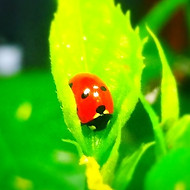
Meet the Cavalry
Got a pest?
Nature's got a solution!
To every pest, a predator.
These beneficial insects are like superheroes for your plants.
It's like having your own personal army of shocktroopers that can take out a pest infestation with laser like precision.
But like any special forces unit, you have to know where and when to use them.
Get familiar with some of the good guys waiting to give you a helping hand.
All species shown were photographed at our facility in Langford, British Columbia.

Red-backed jumping spider
(Phidippus johnsoni)
Not to be confused with the unrelated and highly venomous redback spider (Latrodectus hasselti), the Red-backed jumping spider is one of the largest and most commonly encountered jumping spiders of western North America and is quite docile and harmless to humans and pets, but it will defend itself if threatened and its bite can be painful none the less. Johnsoni is also interesting in the surprising degree of colour difference between male and female. Males have a nearly completely red abdomen, while females have much more complicated patterning which includes reds, whites, blacks and yellows.
As with other jumpers, it is highly intelligent and aware of its surroundings with superb eyesight. A great generalist predator with a particular taste for other spiders!
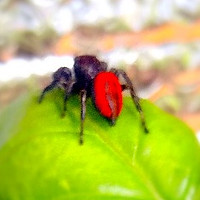

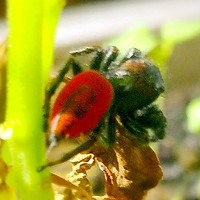
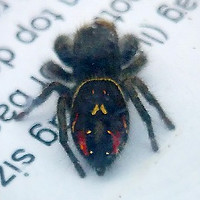
Zebra back spider
(Salticus scenicus)
Like other jumping spiders, it does not build a web to hunt. Instead, it has the ability to move its head independently of its body allowing it to use its four pairs of large eyes to locate prey and orientate itself into the best position to pounce and capture its meal.
Zebra spiders are often noted for their awareness of humans. Upon noticing someone observing them, they will often stop what they are doing to look up at the human and change their behavior accordingly.
Zebra spiders tend to hunt smaller spiders and similar insects, but they have been observed taking on prey items up to 3 times the length of the spider, such as some of the smaller species of moth. This one has just caught a whitefly.

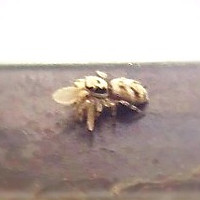
Another cute jumping spider in the same family as the famous "Lucas", but we'll call her "Luca". Generally, as in this case, the abdomen is the easiest way to tell the sex of a spider. Although there are some exceptions, as a rule, males have skinny abdomens, while females have rounder, fuller abdomens.


Minute pirate bug
(Anthocorids)
Although unable to identify the specific species, I am reasonably certain this little guy does belong to the Anthocoridae family
Predacious both as nymphs and adults, They are beneficial biological control agents. Orius insidiosus, the "insidious flower bug", for example, feeds on the eggs of the corn earworm and has been effectively used in greenhouses to control mites and thrips.

Particularly well suited to greenhouse environments, the Brown Lacewing is an exceptional generalist predator with a particular taste for aphids. Brown lacewings are predatory at all mobile stages ot their live-cycle, and these tiny delicate looking insects can single handedly wipe out even heavy aphid infestations, but are also effective against thrips, mites, whiteflies, and even soft bodied scale.
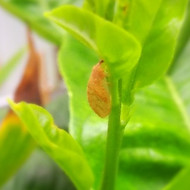
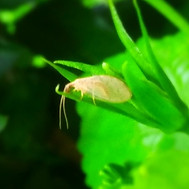
The "Green" Lacewing is another type of lacewing that is readily available for purchase. Just like it's brown cousin, it is an excellent generalist predator. There a a few differences between the two however. Green lacewings are a bit larger than brown lacewings, and aren't quite as suited to greenhouse use as their smaller brown cousin. Additionally, it is only the larvae that are active predators. Adults feed on nectar, pollen, and honeydew. Like al Lacewings they are very effective at controlling aphids, thrips, whitefly, leafhoppers, spider mites (especially red mites) and mealybugs.
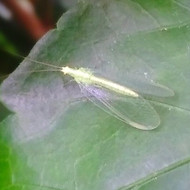
A bit less common than the more plentiful "green" or "brown" Lacewings that are available for purchase, the San Fancisco is an excellent examply of just one of the roughly 1,300–2,000 additional species in this widespread group.


Snakeflies are a distant cousin of lacewings but belong to the order Raphidioptera. The roughly 260 different species that are commonly called snakeflies can be found throughout temperate coniferous forests of the northern hemisphere. Virtually unchanged since the early Jurassic period, these freaky looking insects are completely harmless to you or I, but they are important predators of aphids, mites, and other small arthropods. Although they are extremely effective at controlling pest species, they're long life cycle has prevented them from becoming a commercially available.


Hoverflies, also called bee mimics, flower flies or syrphid flies, make up the insect family Syrphidae. Although they may look like bees, they are in fact "flies" in the order Diptera, and do not possess the ability to sting.
As their common name suggests, Hoverfly adults often ‘hover’ like mini helicopters over nectar and pollen-rich flowers, making the adults important pollinators of flowering plants in many ecosystems worldwide.
The larvae on the other hand, typically have very different diets. In some species, the larvae are saprotrophs, eating decaying plant and animal matter in the soil or in ponds and streams.
In other species, the larvae are insectivores and prey on aphids, thrips, and other plant-sucking insects.
For example, the American Hoverfly (Eupeodes americanus) is commercially available, and is found throughout North America. The adult feeds on nectar while the larva feeds on aphids. The larva is very voracious and able to eat up to 300 aphids during its development.
These should be a welcome visitor to any garden.
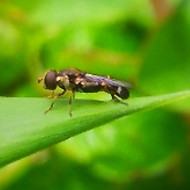

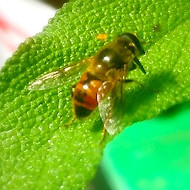



Ground beetles belong to a very large family with thousands of species. These insects are predatory as both adults and larvae. The larvae are found underground. Most adults forage at the soil surface, although some will climb plants to search for prey.
Ground beetles feed on eggs and larvae of root maggots, aphids, caterpillars, beetle larvae, snails, slugs, and weed seeds. They are typically dark and shiny, color varies but most are dark brown, black, or metallic. The wing covers often have striations or pits and they have threadlike antennae.
This particular species was introduced from europe to north america in the late 1800's. It has since become an important part of the ecosystem, and an invaluable biological control species due to its preference for disturbed soils, such as those found on farms or in gardens.


These tiny little Arachnida can look pretty scary, but are totally harmless to you and me. That is, if you can even spot them in the first place. these guys are on average just 4mm long, with their arms extended!
Despite their tiny size, Pseudoscorpions are extremely beneficial since they prey on a number of garden pests including moth larvae, springtails, booklice, ants, mites, thrips, fungus gnats and whiteflies flies.

Commonly found in the UK, this is another example of an introduced species that has become a valuable part of our eco-system. Campyloneura virgula is small, Usually reaching a length of around 4mm.
A distinctively marked species with very long antennae and a bright yellow cuneus, tipped with dark red. Nymphs are yellow, with red-banded antennae and a red stripe on the margins of the pronotum, reminiscent of racing stripes, which is oddly appropriate for this fast moving bug.
Campyloneura virgula hunts for small insects, such as mites, aphids, thrips, soft bodied scale and whitefly.

Green Metallic Bee (a.k.a. Green Sweat bee)
Another important pollinator of a wide range of plants, these bees can be easily spotted because of their bright metallic green or blue colouration. Females are bright green all over, whereas males have a bright coloured head and thorax with a yellow-and-black striped abdomen.
The common name "sweat bee" stems from the fact that they are attracted to human sweat, presumably as a source of salt. Despite this, they are rarely known to sting and are generally quite docile.
Interestingly, Toronto .Canada has named this species it's official bee due to its uncommon tendency to allow other Bicoloured Agapostemon individuals (complete strangers) to share their nests. So rather than being hostile, it is welcoming of newcomers, a trait the people of Toronto feel they share with the brightly coloured little bee.
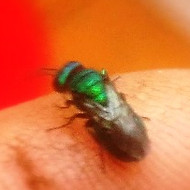
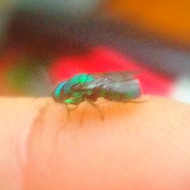
Painted Lady Beetle
(Mulsantina picta)
Mulsantina picta is widespread across the United States and southern Canada. It is especially associated with pine forests and is an aphid and adelgid predator. Thus making M. picta a rather dominant species in older pine trees habitats (since they are conifer specialist), which are known to have low aphid densities

Three-banded lady beetle
(Coccinella trifasciata)
This uniquely marked beetle is another species of lady beetle in the family Coccinellidae. It has a broad distribution, including North America, Europe, Northern Asia (excluding China), Oceania, and Southern Asia. It has become increasingly rare in recent years, but remains an important species for control of a number of pests


Praying Mantis




